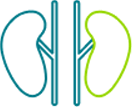POMC, PCSK1, and LEPR deficiency are all rare autosomal recessive disorders that lead to hyperphagia and early-onset, severe obesity1-3
Proopiomelanocortin deficiency
Proprotein convertase subtilisin/kexin type 1 deficiency
Leptin receptor deficiency
POMC, PCSK1, and LEPR deficiency impact various systems throughout the body1,4-9

Brain
- Hyperphagia and consequent obesity
Endocrine
- Hyperinsulinemia
Reproductive
- Hypogonadotropic hypogonadism
- Delayed puberty
Additional clinical features may include:
- Endocrine: Diabetes
- Frequent infections
These conditions can be difficult to diagnose based solely on clinical manifestations, but genetic testing may be able to help.2 For more information about genetic testing for POMC, PCSK1, and LEPR deficiency, please visit UncoveringRareObesity.com
Uncovering Rare Obesity® can help support a diagnosis of POMC, PCSK1, or LEPR deficiency
A no-charge,* genetic testing program for MC4R pathway diseases
Genetic test provides insights
The gene panel includes 87 genes and 1 chromosome region, reflective of nearly all of the most frequently tested genes associated with obesity. This is not a test for Prader-Willi syndrome.10
Tailored support for results interpretation
The program provides you with access to a geneticist to help interpret results, as well as board-certified genetic counselors for your patients. Services are provided through third-party partners.
Testing conducted by a laboratory partner
DNA testing is conducted by PreventionGenetics, a CLIA-accredited clinical laboratory.
Blood and OCD-100 buccal swab
sample collection kits are available.
For more information about the genetic testing program, visit Uncovering Rare Obesity.com
*Rhythm Pharmaceuticals covers the cost of the test and provides sample collection kits. Patients are responsible for office visit, sample collection, or other costs.
CLIA=Clinical Laboratory Improvement Amendments; GI=gastrointestinal; LEPR=leptin receptor; MC4R=melanocortin-4 receptor; PCSK1=proprotein convertase subtilisin/kexin type 1; POMC=proopiomelanocortin.
References: 1. Styne DM, Arslanian SA, Connor EL, et al. Pediatric obesity-assessment, treatment, and prevention: An endocrine society clinical practice guideline. J Clin Endocrinol Metab. 2017;102(3):709-757. doi:10.1210/jc.2016-2573. 2. Malhotra S, Sivasubramanian R, Srivastava G. Evaluation and management of early onset genetic obesity in childhood. J Pediatr Genet. 2021;10(3):194-204. doi:10.1055/s-0041-1731035. 3. Wabitsch M, Farooqi S, Flück CE, et al. Natural history of obesity due to POMC, PCSK1, and LEPR deficiency and the impact of setmelanotide. J Endocr Soc. 2022;6(6):bvac057. Published April 15, 2022. doi:10.1210/jendso/bvac057. 4. Gregoric N, Groselj U, Bratina N, et al. Two cases with an early presented proopiomelanocortin deficiency-a long-term follow-up and systematic literature review. Front Endocrinol (Lausanne). 2021;12:689387. doi:10.3389/fendo.2021.689387. 5. Huvenne H, Dubern B, Clément K, Poitou C. Rare genetic forms of obesity: Clinical approach and current treatments in 2016. Obes Facts. 2016;9(3):158-173. doi:10.1159/000445061. 6. Stijnen P, Ramos-Molina B, O'Rahilly S, Creemers JW. PCSK1 mutations and human endocrinopathies: From obesity to gastrointestinal disorders. Endocr Rev. 2016;37(4):347-371. doi:10.1210/er.2015-1117. 7. Pépin L, Colin E, Tessarech M, et al. A new case of PCSK1 pathogenic variant with congenital proprotein convertase 1/3 Deficiency and literature review. J Clin Endocrinol Metab. 2019;104(4):985-993. doi:10.1210/jc.2018-01854. 8. Farooqi IS, O'Rahilly S. 20 years of leptin: human disorders of leptin action. J Endocrinol. 2014;223(1):T63-T70. doi:10.1530/JOE-14-0480. 9. Farooqi IS, Wangensteen T, Collins S, et al. Clinical and molecular genetic spectrum of congenital deficiency of the leptin receptor. N Engl J Med. 2007;356(3):237-247. doi:10.1056/NEJMoa063988. 10. UncoveringRareObesity.com. Genetic Testing for Obesity. 2024. Accessed December 8, 2024. https://uncoveringrareobesity.com/.
